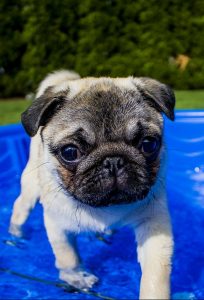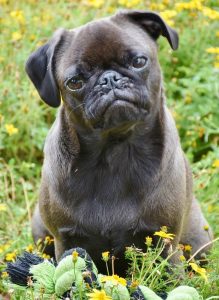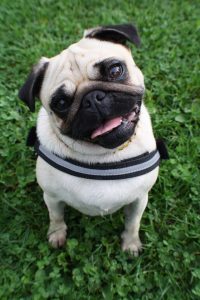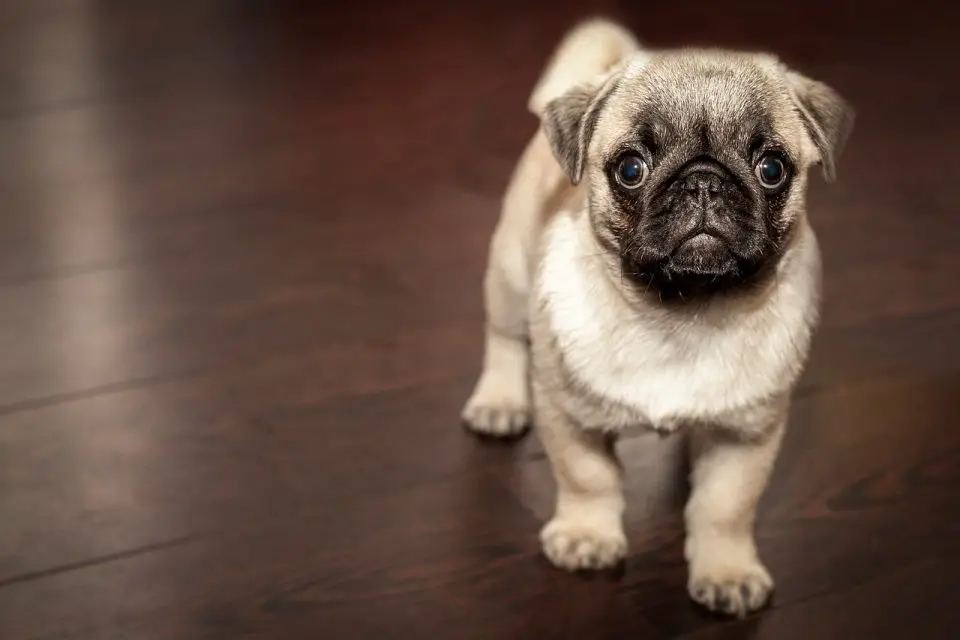A Little About Pugs
I am sure that most people have come across one of these delightful dogs at one time or another.
You will recognize them by their wrinkled faces and short muzzles. Another recognizable feature of the Pug is the cute little curled tail.
The Pug breed is often described as ‘a lot of dog in a little space’ and that is exactly what they are. They may be strong willed, but they are seldom aggressive.
The breed is suitable for families with children if the children are not too rough. They can be quiet and docile when they are tired but have boundless amounts of energy when they are awake.
The breed is playful, and they thrive on their human companions, often referred to as shadows because they appear to literally be hooked onto the leg on their owner.
Pugs have fine glossy coats which you will see in a variety of colours although the most common colours are fawn and black.
The AKC recognizes black although the Canadian Kennel Club will accept black, apricot, and fawn.
The average life of a Pug is 11 years, in line with the average ages of any other breed in relation to the size.
Pugs are recognized as gentle little dogs, very sociable and good companions. They have even tempers and are – as any Pug owner will tell you – delightfully charming companions.
Pugs came to Europe from China in the 16th century. They became extremely popular in the Netherlands before being introduced to the UK.
Queen Victoria had a Pug as a pet and passed on her love of them to other members of the Royal family.
Many celebrities own Pugs and they remain a popular breed, being judged Best in Show in the World Dog Show of 2004.
Do Pugs Shed?
Before you invest in any dog you should ask this question, particularly if you or a family member has any allergies.
So, do Pugs Shed?
| Unfortunately, Pugs do shed, they is considered a high shedder. They shed all year round, unlike some dogs that only shed twice a year. |
In many breeds the hair goes through a three-step growth process which is growth, rest, and fallout. With Pugs the cycle is much faster.
You may think that because the Pug is a small dog there will not be that much hair – you would be wrong! They shed a lot, and all the time, with more shedding at certain times of the year than others.
Short History of the Pug
First known sources of the Pug came from China where the breed was popular in the court through the Song Dynasty. They were bred for the ruling families and highly valued by Chinese Emperors.
Royal Pugs were kept in luxury and guarded in case of theft. Later information shows that Pugs were kept by Buddhist monks in some monasteries.
In the 16th century Pugs first made their appearance in the European courts. Reportedly the official dog at the House of Orange in 1572 was a Pug.
When William III and Mary II traveled to England to accept the throne a Pug came with them. This was in 1688.
At about this time a Pug may have been bred with a King Charles Spaniel which is how we see some characteristics of the Spaniel in the modern Pug.
The Pug and Art
The breed continued to be popular all over Europe, with Pugs being the subject of many paintings from Goya. In Italy Pugs used to ride on the front of carriages dressed to match the attire of the coachman.
The 18th century saw Pugs in the UK. They were painted by William Hogarth who had several as his own pets. You can see a portrait of his Pug called Trump in the Tate Gallery.
If you are interested in art, then you may have noticed that paintings of Pugs always show them with longer ears and noses. Often you would see them with cropped ears.
The appearance seems to have changed when Pugs can to Europe after 1860. Pictures of these Pugs show them with shorter legs, and uncropped ears. Ear cropping became illegal in 1885.
Pugs were first introduced to the USA in the 19th century and found their way into many American homes as well as becoming recognized by the American Kennel Club in 1885.
What is a Pugs Coat Like?
 Pugs have double coats. This is exactly as it sounds as they have two fur coats.
Pugs have double coats. This is exactly as it sounds as they have two fur coats.
This is made up of an inner layer of fur, called an undercoat, and an outer layer called a topcoat. Both are vital to keep a Pug comfortable through the year.
Should you run your fingers through the Pug’s coat you will feel a wool-like layer underneath the upper coat. This undercoat serves as an insulator and is there to keep the Pug warm as the temperatures drop.
You will notice that the outside of the coat has a rough feel to it. The upper coat protects the dog from elements such as snow, debris, and rough terrain.
Many dogs have double coats, Pugs are not the only breed to sport them. Husky, Corgi, and Australian Shepherd all have double coats to protect them.
While a double coat serves as protection it also means that the dog has double the amount of hair and therefore potentially double the amount of shedding during the shedding season.
Why do Pugs Shed so Much?
Because of the double coat, the Pug will shed more than other breeds with single coats.
The main reason is because the Pug hairs are so tightly packed together. A Pug has an average of 600 hairs to a square inch!
Other breeds average around 150 hairs to one square inch, which is a huge difference and makes for a lot of shedding for the Pug. The more hairs on the dog, the more will be on your furniture!
Additionally, the growth process of the hair, namely growth, rest, and shedding, happens faster in Pugs than for other breeds.
How Much do Pugs Shed?
Most Pug owners will tell you that their pooch sheds a lot! In fact, most will tell you that they shed excessively and heavily.
- 60% of Pug owners agree their pooch sheds heavily
- 20% say their pooch has a mixed shedding habit
- 10% admit their dog sheds moderately
- 10% say their dog is a low shedder
Based on these figures it is more than likely that any Pug you buy will fall into the high shedder range. Of course, you may be lucky to have a moderately shedding pooch, but that may not be the case.
Naturally, each Pug is different, and some will shed less than others, but most owners accept that hair on the furniture and floor is a part of having a Pug as a pet.
Do not be fooled into thinking that your Pug will not shed because he is a puppy.
Pugs do not start to shed until they are between 1 and 2 years. Get your vacuum cleaner ready because it will start sooner or later!
Apart from shedding pretty much all the time, you can still expect a heavy shed twice a year when the seasons change.
All double coated breeds will do this, and the Pug is no different. Other than brushing and bathing there is little you can do about it.
When do Pugs Shed the Most
Although Pugs shed the whole year round, they will shed more as the seasons change.
You can expect more hair during Spring and Autumn. Seasonal shedding is caused by changes in temperature through the year.
Another reason why your pooch may shed more is to do with the hours of sunlight through the day. The more sunlight, the more shedding.
When the days are shorter the Pug will also shed more as the brain realizes that it should start to grow a winter coat.
As the days get longer the signal is sent to shed the winter coat so that the dog does not overheat.
Interestingly, bathing your Pug will also make him shed more than normal. The process of rubbing shampoo into the coat breaks up the natural oils which are found on the skin.
The skin, which has been holding the dead hairs release them all, and therefore you end up with a bath full of hair after you bathe your pooch.
Baths are a good way to rid the dog of dead hair but be aware that they will shed a lot then!
Age is yet another reason why a Pug may shed more. As your dog approaches the 1 ½ mark you will notice that shedding increases to far heavier than when they were pups.
Pups tend not to shed heavily so many people think that the breed does not shed heavily – they do as soon as the reach 18 months of age.
How to Combat Pugs shedding
 Sweeping and vacuuming is the best and the quickest way to keep shed hair under control.
Sweeping and vacuuming is the best and the quickest way to keep shed hair under control.
If you have a Pug, then this should become a part of your daily routine. Keep your vacuum in a place where it can be hauled out every other day at the least to dispose of hair.
A point to remember about Pug hairs is that if they are not vacuumed off the carpet regularly, they will dig deeper into the fibres of the carpet and it will be harder to remove them.
Having a vacuum cleaner with detachable tools will also make life easier as you can use one to reach into small places.
For clothing you may want to consider getting, and keeping close at hand, a lint roller. This will remove hairs from clothing and other surfaces such as sofas, cushions, and beds.
Of course, as far as your Pug is concerned the best way to keep hair under control is to brush daily. Because the hair is very thick it all gets stuck in his coat and may cause matting.
Brushing also helps to keep hair around the house under control and if possible, you should do this outside.
Any hair that is caught up with other hairs will meet oil from the skin. It will block the growth of new hair follicles and soon start to smell.
Depending on how much your Pug sheds you will need to brush between once a day and three times a week.
If you plan on bathing your pooch, then you should brush his coat right before the bath and again right afterwards once your pooch is dry.
Using a hair dryer after a bath will help by blowing off any excess hair that is loose and ready to fall out.
Diet may Help Reduce Shedding
A coat that is in good condition is less likely to shed excessively so adding Omega 3 fatty acid is a good idea. Poor hair condition means that they will break more often and therefore shed more.
Although Omega 3 fatty acids will not cause your dog to shed any less, it will at least keep skin in good condition, and he will not shed any more than normal.
Another bonus of omega 3 is that it keeps your Pug’s joints healthy and prevents inflammation.
If you plan to include Omega 3 into the diet, then make sure that it comes from wild fish instead of farm fished stock as these can interfere with DHA and EPA levels.
There are other supplements which may help with shedding, namely flaxseed oil, linoleic acid, and cold pressed hemp seed oil. You should discuss with your vet to get the right supplements for your dog.
A healthy diet which is nutrient-dense will do wonders to maintain your Pugs coat and keep it shiny. This helps to stop hair becoming brittle and breaking off, so you may see a reduction is shed hair.
It is a good idea, when buying dog food, that you check the label and see the ingredients which are beneficial, namely fish oils and fishmeal.
Naturally, your Pug needs to have a bowl of fresh water at hand all the time. This is also essential to keep the coat in good condition. A dehydrated dog will often lose its hair.
Equipment Help to Combat Pugs Shedding
In addition to doggie shampoo (which should be designed for dogs and not you!) you may want to add some items to reduce shedding.
De-shedding tools
This works to get rid of hairs which are deep seated in the coat. You will be amazed at how much hair you can remove simply by using this tool.
Buying a stainless tool will ensure that it lasts longer and feels comfortable to hold as you brush.
Because this tool is designed to remove deep-seated hair, it does not work if you are lucky to have a Pug with a single coat.
Grooming gloves
This is exactly as it is described, i.e. a glove which you wear as you brush your pooch. Most grooming gloves come with over 250 rubber tips for best results.
There is little else to do with this glove but if your pooch is uncomfortable with a brush, he may feel more at home with this.
The glove gets right down to the deep hairs and gently removes them while your pooch feels as if you are simply stroking them.
Bristle brushes
A bristle brush is what you should use after you have bathed and used the de shedding tool. This brush adds a smooth, shiny look to the hair.
These brushes also get rid of dandruff and any debris which is trapped in the fur. Some owners use this for applying conditioner to the hair as it distributes the product evenly over the coat.
The brush will serve to remove allergens and irritants so is a good idea for people who suffer as well as dogs, who sometimes are affected by seasonal pollen.
Are Pugs Considered to be Hypoallergenic?
No dog is 100% hypoallergenic, and Pugs can NOT be classed as hypoallergenic. Pugs with double coats are even less hypoallergenic.
For anyone with dog allergies, this breed is unfortunately one to avoid. Fur and skin easily loosen and causes allergic reactions to some people.
While every dog will shed to some degree the Pug will shed more than most. Even the single-coated Pug will shed a little.
Allergies are caused by pet dander coming into contact with our skin, eyes or nose and they are carried by hair, saliva, and loose dog skin.
Some breeds produce less of these, but unfortunately the cute Pug produces more.
You may think that because the Pug’s hair is short that they are less hypoallergenic. The fact that they shed so much disputes this.
The Pug also has many skin folds where dander accumulates and when set loose, greatly affects sensitive people.
Do Some Pugs Shed More Than Others?
Whether one Pug sheds more than others depends entirely on the coat of the dog. If you are lucky enough to have a Pug with a single coat, it will shed moderately.
For any Pug with a double coat you can expect mountains of hair because the shedding process is different from single haired dogs.
A strange fact is that black Pugs shed less, even if they have a double coat.
While having a dark-coloured dog in a very hot climate may not seem the best idea because of heat absorption, if your dog can cope with higher temperatures and you do not like heaps of hair, then this may be an option for you.
Health Reasons for Increased Shedding in Pugs
Pugs need good quality food in order to keep them healthy. More importantly, they need a good diet to keep their skin in good condition. A healthy skin will reduce shedding a little.
Other causes for your Pug to shed are when entering the heat cycle, being pregnant and lactating.
At these times you will find that your dog sheds a lot more. This will return to normal after the pups are weaned.
A diet which is not rich in fatty acids will mean that your pooch shed more. So make sure to check the ingredients of the food.
Just as humans, the Pug can suffer from skin allergies and pest infestations. This will irritate the skin and you may find that your Pug scratches more than often.
The dog may also develop bald patches where they have licked more than normal because something is irritating the skin.
Pugs prefer not to be left alone for too long as they may develop separation anxiety which can cause them to lick a spot more than they should. This will cause the hair to fall out and a bald spot to start.
Stress and tension are not things that this breed likes, as they are primarily companion dogs who get along with almost all people.
Loud noises such as fireworks will disturb them and cause them to lick until a sore spot appears.
Final Thoughts: Do Pugs Shed?
 Pugs are one of the most delightful breeds. Not only are they good companions, they hardly ever become aggressive and certainly are not guard dogs!
Pugs are one of the most delightful breeds. Not only are they good companions, they hardly ever become aggressive and certainly are not guard dogs!
They are suitable for both houses and apartments, and do not need a great amount of exercise each day.
They are happy to stay curled up with their owner on the sofa or sit outside in the garden at their owner’s feet. Mind you, most Pugs would prefer sitting on a lap to sitting on the ground!
Unfortunately, the off-putting factor with Pugs is that they shed so much.
If you do not have the time to devote to a good brushing every day, and a bath once a week, then this may not be the best choice of dog for you.
If you can handle the shedding and keep it under control, then you will be rewarded with a dog who adores you and makes the most delightful companion.
Thank you for reading do Pugs shed, have a great day!
